PAGE 57 – JANUARY 2007
H O T I D E A S F O R S M A L L R A I L R O A D S

At the moment, I have three (two are shown above – SAP Lines and the unfinished Boot Hill).
This month’s SCRAPBOOK shows some more shelf ideas. Some are completed, some
are under construction, and some are still in the design stages. They
all contain some good ideas that you can put to use!
H A P P Y N E W Y E A R , E V E R Y O N E !
AGING SHELVES CAN STILL SPARKLE

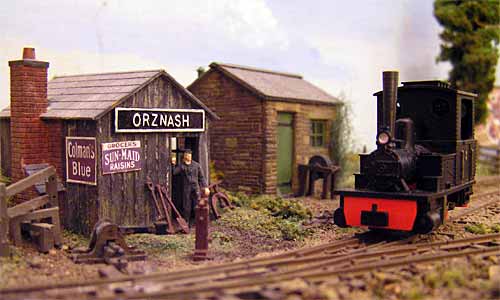
Photos show Oznash overall (left), up close (above) and crated (below).
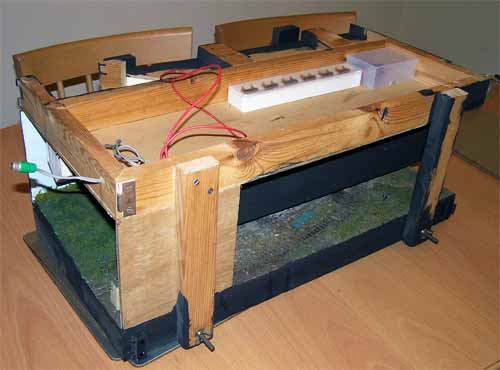
Kevin Payne, from Sussex, U.K., recently unearthed a 20-year-old layout from his loft, dusted it off and set it up, and found it was still in good condition. It’s called Orznash, and the photos speak for themselves. It’s 48x12in (120x30cm) and is built in HO9 (HOn30) scale. When traveling to exhibitions, it packs up into a 24x12x12in crate, as shown.
Kevin comments, “All of the home-built stock is long gone to other owners, so here you see an old Egger Bahn loco at work.
Orznash was inspired by the same Brede Valley waterworks line that you feature in your [site], from the area where I grew up. The layout departed pretty radically from that inspiration, but the wharf on a muddy river holds to tradition. The name, incidentally, comes from a very tiny hamlet about five miles from where I was born, but the that is in a steep, wooded valley with a fast-flowing stream, so looks nothing like the layout! ”
Kevin is now working on a new version of Orznash, built to a larger scale (1:18!). More information to come.
AN HO MODULE THAT CAN STAND ON ITS OWN
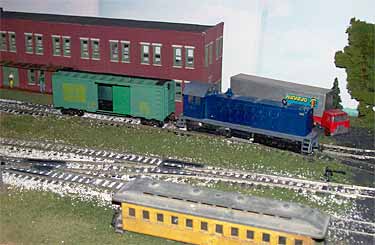
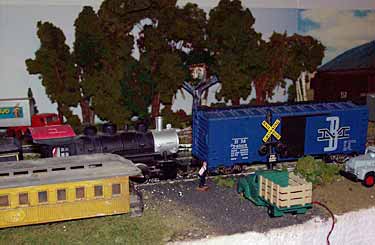
Tim Shred, from Addison, New York USA, built this small station, Apple Creek, as one terminal section of his projected around-the-walls model railway, the Georgetown & Charleston RR. But thus far he has found this little shelf to be so much fun to operate that he hasn’t yet built any more of the layout! Time period is the 1960’s, so 40-foot cars are still very much in use. As a design tip, Tim points out the all the turnouts can be switched using ground throws, because they’re all within arm’s length of the operator at the control panel.Tim also comments, “It was quite a surprise to discover the amount of operating fun there is to be had in such a small area. The car card /waybill system I use is sort of ‘manual random generation.’ I use one die to determine the number of cars to be switched (only one because the layout size does restrict train size). I then draw out the given number of waybills from my file box without looking and assign them to the appropriate cars. So then I’m good to go for the next four movements of those cars.”
Below is a not-to-scale drawing of the Apple Creek layout, and a snapshot of early construction. Notice the changes that Tim made from his drawing to the actual railroad. This is quite normal for a model railroad while it’s being built!

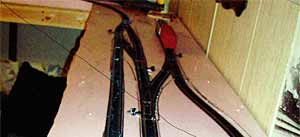
TWO ULTRA-SMALL SHELVES OFFER LOTS OF OPERATION
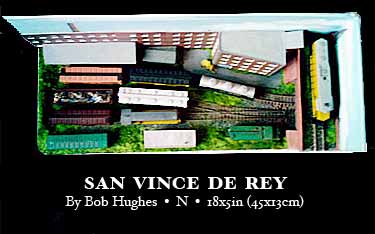
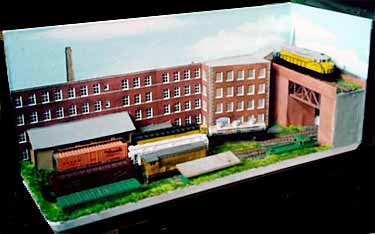
Bob Hughes, from Sandbach, Cheshire U.K., has contributed to these pages a cornucopia of very small layouts in a wide variety of scales (see Scrapbooks #51, #44, and #41). Here are two of his newest creations, in N and OO scales. Above is Bob’s “take” on the Inglenook switching layout, San Vince de Rey, built in U.S.-style N scale in a space just 18 inches long (plus a fiddle yard track of another 18in). Bob independently confirmed my discovery (in my book, Creating Micro Layouts) that an Inglenook can be reduced in size from eight cars to six and remain interesting to operate as a switching problem.
Bob reports: “An Inglenook is a three-road shunting puzzle, usually with a capacity of eight wagons in 11 spaces (3-3-5) but they can be built smaller. I originally intended to operate this layout with five freight cars in the seven spaces (2-2-3), but after a test run I have decided that using six cars makes the puzzle much more interesting. In deviation from standard Inglenook practice it is required to leave a car standing on the points (turnout) between the two short sidings in order to retrieve a car from the far end of the long siding. But I find this acceptable as there are no rules against it when shunting a full sized yard.”
In his second layout, Bob manages to find switching fun in an even-smaller area, with an even-larger scale! Earle’s Quay (below) is an OO layout (4mm to the foot running on 16.5mm gauge) built on a 11.75×6.5in tea tray (30×16.5cm).
Bob’s description: “The scene is a quayside [dockside] with warehouses forming the backdrop. The train appears from the right, propelling wagons to the inlaid quayside track or the warehouse loading bay. Offstage there is a cassette which plugs into either track. Layout total capacity is a loco and three wagons but the stock can be exchanged offstage for variety. In the foreground there is a fishing boat in the harbour, which is designed so that it can be filled with cold tea to simulate muddy water. Well, it is built on a tea tray!”
For his next trick, Bob is building an O scale switching layout on a same-sized tea tray. Watch this space!
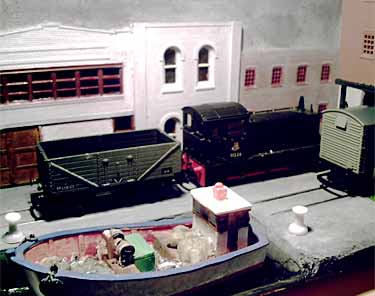
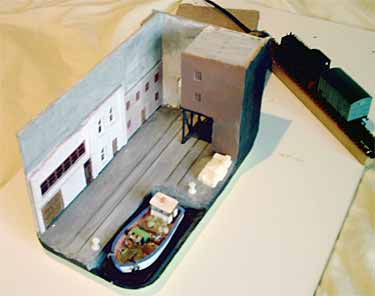
SMALL, SIMPLE SHELF SUPPORTS SHUNTING SATISFACTION
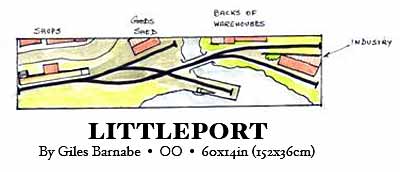 Littleport is a shelf-switching layout designed by Giles Barnabe, from London U.K., whose designs have often appeared in these pages. “This idea,” Giles notes, “is based on a similar but larger track design by Tom, a fellow member of the Wealden Railway Group in the UK. Here the design is used as a small British harbour, so with smaller rolling stock you can reduce the length to 60 inches. Width as drawn is 14 inches, but could usefully be widened a bit, particularly if you want to model a small coasting vessel alongside the pier.
Littleport is a shelf-switching layout designed by Giles Barnabe, from London U.K., whose designs have often appeared in these pages. “This idea,” Giles notes, “is based on a similar but larger track design by Tom, a fellow member of the Wealden Railway Group in the UK. Here the design is used as a small British harbour, so with smaller rolling stock you can reduce the length to 60 inches. Width as drawn is 14 inches, but could usefully be widened a bit, particularly if you want to model a small coasting vessel alongside the pier.
“Trackwork uses the Peco small wye turnout by the station, with a Setrack RH leading to the crossing, and a curved turnout beyond the bridge. The layout is a “twig” serving a small harbour, and is based on an Inglenook design with an added fiddle yard track. Small tank engines or diesels and four-wheeled wagons work the sidings while occasionally a single unit railcar or steam auto-train (push-pull coach and locomotive) appears to serve the tiny passenger station.
“Despite its simplicity the layout could be quite challenging to work, perhaps using a card-order system to generate goods traffic.” It’s a busy layout indeed, and quite scenic, in a relatively small area!
THIS LITTLE SHELF SHUNTER LITERALLY ROCKS!
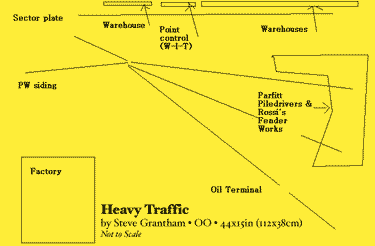

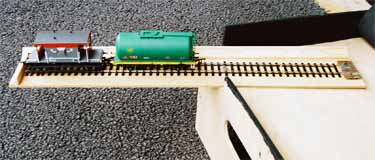 Steve Grantham, from Bubwith, North Yorkshire U.K., is building and exhibiting this small OO switching layout, Heavy Traffic. According to Steve, it represents “an imaginary modern industrial park that has (sensibly) incorporated rail access. I run BR Class 08 0-6-0 diesel shunters which are perfect for this sort of operation.
Steve Grantham, from Bubwith, North Yorkshire U.K., is building and exhibiting this small OO switching layout, Heavy Traffic. According to Steve, it represents “an imaginary modern industrial park that has (sensibly) incorporated rail access. I run BR Class 08 0-6-0 diesel shunters which are perfect for this sort of operation.
“The name is taken from an album title by my favourite rock band, Status Quo. The named industries will reflect names of band members and certain scenic cameos will reflect other Quo albums or songs.” Key to operations is the sector plate (shown at left) that feeds the Inglenook style spurs radiating from a three-way turnout. Heavy Traffic, though still under construction, has appeared at several model exhibitions this year, and is booked for more in 2007. We’ll try to bring you more photos as the scenery progresses.
SOMETIMES A FOREIGN PROTOTYPE CAN ADD EXCITEMENT
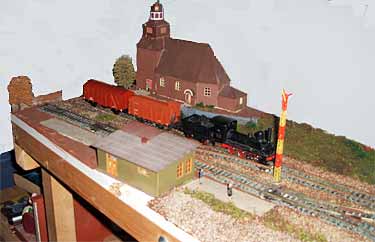
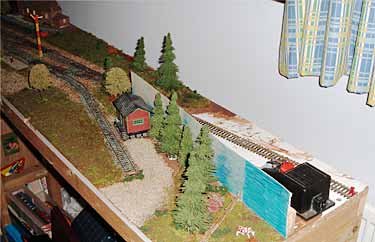
This delightful HO Swedish shelf layout, Stog (pronounced “Stoo-ey”), was built by Matt Scrutton, from Chertsey, Surrey U.K. Matt contributed a previous Swedish style layout to these pages in #43. Stog measures 56x15in (142x38cm). It’s in the familiar “Tymesaver” pattern of spurs running from each of the four corners of a runaround siding. One of the spurs forms a small fiddle yard (above right).
Modeling the railways of a foreign country can be challenging. Matt says, “The rolling stock is quite varied and is mostly second hand stuff from fellow Swedish modellers. Most is commercial that has been bashed into various good resemblences of Swedish locos. I model the 50s so I get the best era of SJ (Swedish railway company), with all the vintage diesels and most of the interesting steam locos…
“Passenger services are of three options: one is steam hauled with scratchbuilt four- wheel coaches, another is a single coach with a heavy goods engine, and the third is the ubiquitous SJ railcar, of which I have a motor and a trailer car. The line is mainly a freight line (one passenger train for every three freight) as this is my preferred method of operation.”
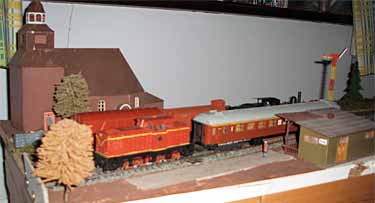
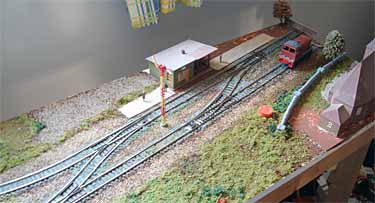
THE CASE OF THE SECTOR PLATE SWITCHEROO

Versif, a pseudonymous contributor from Kirkby in Ashfield, Nottinghamshire U.K., has designed a most unusual sector plate on his new shelf layout, Turner Point Yard. The basic design is a variation of Jack Trollope’s classic Box Street Yard, using a double-slip switch to give great flexibility in very little space.
The sector plate (to the right of the red overbridge in the drawing above) holds an SW9 diesel switch engine and one 50ft car clear of the switch … and much of the time that combination is sufficient to perform runarounds without moving the sector plate. But occasionally, a runaround maneuver with a loco and two freight cars is required. In that case, the stock is loaded onto the straight leg of the sector plate and then the plate is moved to align with the other approach track, allowing completion of the maneuver.
Versif credits fellow English modeler Chris Gilbert with the original idea of including a turnout on the sector plate; the track design of this particular application of the idea is original. We hope to bring you more photos as scenic work gets underway (if we can persuade Versif to stop running trains long enough to get some work done on the layout!).
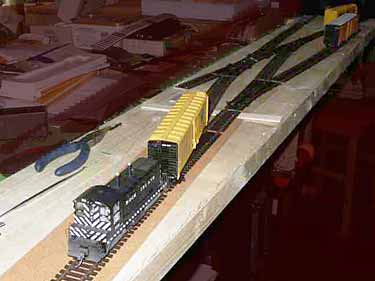
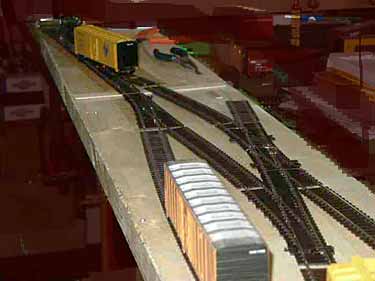
FOR CONTINUOUS ACTION, CHOOSE A LOCO STABLE
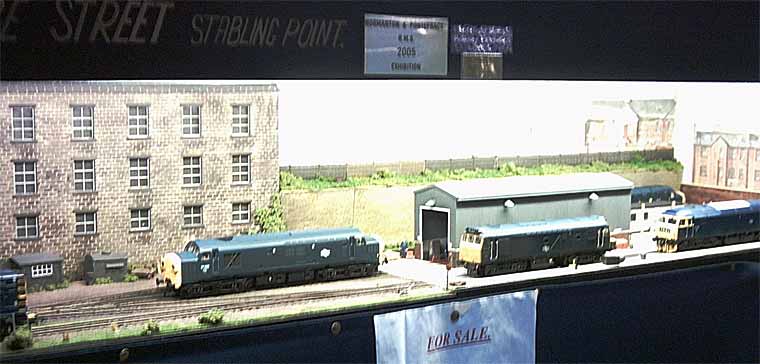
Richard Scott, from Pontefract, West Yorkshire, U.K., has chosen to model one of the busiest places on any railroad — the “stabling point” where locomotives refuel, are inspected, and remain parked until their next duty. Richard has crammed all this activity into a 48x11in (120x28cm) shelf, George Street Stabling Point. It’s OO scale, runs classic BR blue diesels, and covers the 1976 to 1986 period. The track plan consists of a fan of three sidings coming from a three-way point (turnout), with a kickback siding on the front spur, usually used for tank wagons of fuel.
What goes on here? Richard describes it: “The majority of the movements are loco based — arriving and departing — and revolve around them moving from the storage road to the inspection shed and fuel roads before departure. The movements vary among the three roads, where the next loco needed may be at the back of the storage line, boxed in by more locos. So shunting of the other locos has to take place first. Occasionally there are deliveries of parts from the stores in covered vans, diesel fuel deliveries in tankers, and a few engineers’ wagons that may take up space on the storage road, just to make the shunting more interesting, I sometimes bring in a breakdown crane to add a little variety.”
George Street Stabling Point sounds like a very busy place!
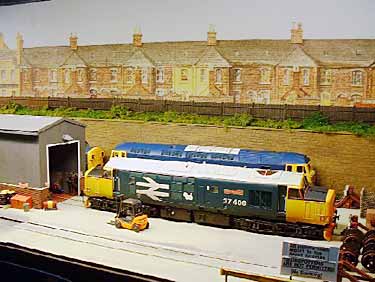
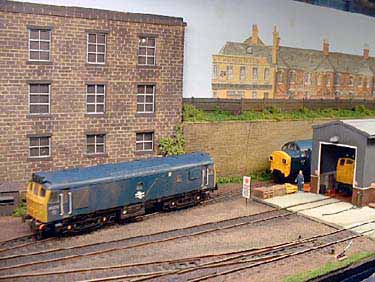
AND NOW FOR A FEW UPDATES ABOUT OTHER SHELF LAYOUTS
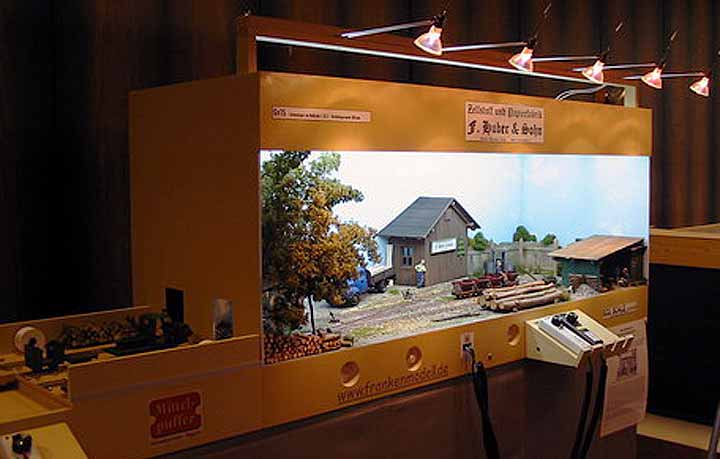
We first encountered the delightful Gn15 layout, Huber & Sohn Paper Mill, in Scrapbook #54 while it was under construction. It’s a 130x45cm (51x18in) display layout that is nearly complete and recently appeared at its first exhibition in Lahnstein /Koblenz, as shown in these photographs from its builder, Alexander Lösch, from Elfershausen in Bavaria, Germany.
Operations cover the complete cycle from logs entering the sawmill to rolls of paper leaving the plant. There’s lots more information and photographs of this very attractive layout at Alexander’s website.
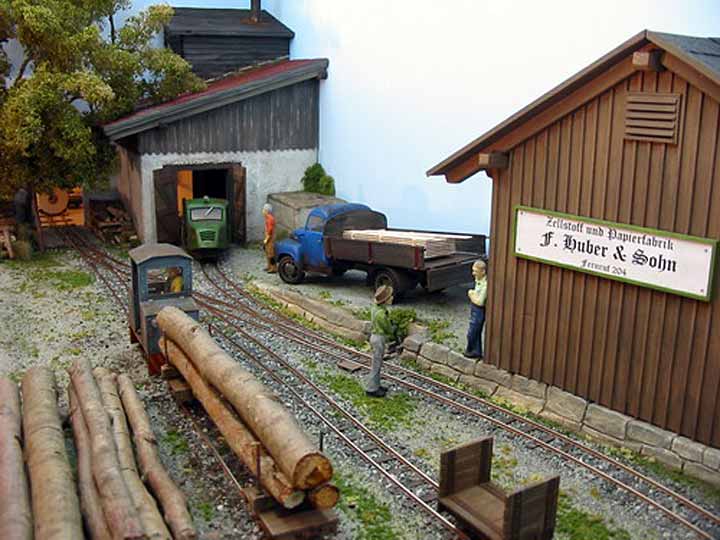
Frank Luczak, from Glastonbury, Connecticut USA, built his micro layout (below) in HO scale based on my design of the Amalgamated Terminal RR. Frank’s version represents a small terminal of the New Haven RR, and these are his first published photos of the line. He built the line as a small-space, small scale diversion from his basement-sized layout, a hi-rail operating model of the St. Johnsbury, Vermont USA area with CPRail, MEC, B&M and LV railroads. The large layout, says Frank, “is a lot of fun but this small module was and is a fine diversion.”
It’s always a treat for me to see layouts built to my designs, and I hope you share my pleasure in watching the colorful NHRR stock in operation!
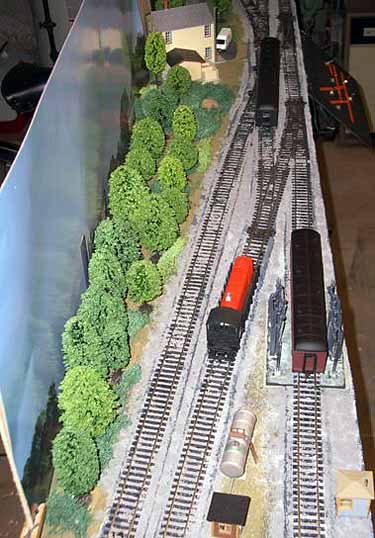
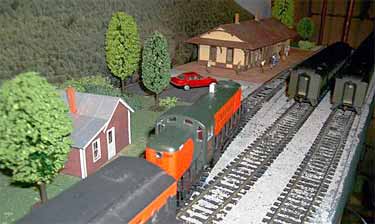
The New Haven stub terminal is a busy place,with commuter trains from New York arriving often (above). The overview (at left) shows the track plan and in the foreground, Frank’s prototypical car-washer model.
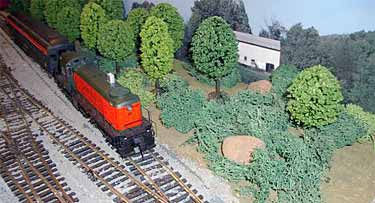
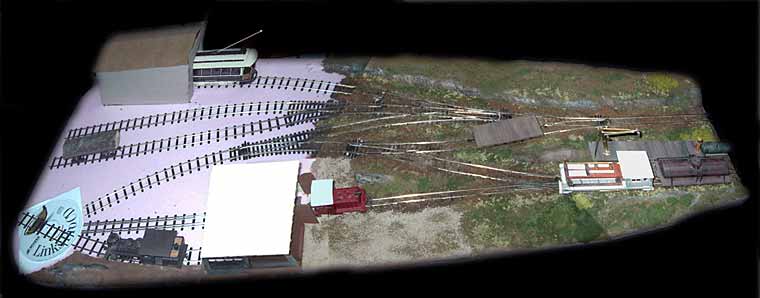
Leave a Reply